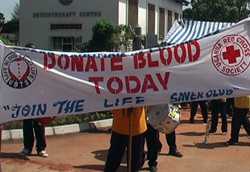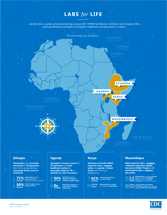Improving Blood Safety in Uganda

On World Blood Donor Day 2009 in Uganda, the Uganda Blood Transfusion Service and Red Cross ask the public to "Donate Blood Today."
In the early years of the global HIV/AIDS epidemic, a safe blood supply was a critical concern for stopping the transmission of HIV for developed and developing countries alike. Over the years great strides have been made in improving blood safety, but it continues to be an ongoing challenge in developing countries, requiring improved infrastructure and ongoing technical assistance. CDC, through its work in implementing the President's Emergency Plan for AIDS Relief (PEPFAR), has made blood safety a critical component of its HIV prevention activities.
CDC's support for blood safety in Uganda illustrates the capacity to support countries in developing sustainable, country-owned public health systems.
History of Blood Safety in Uganda
The Uganda Blood Transfusion Services (UBTS), the national body responsible for all blood safety activities in Uganda, enables surgeons and other medical professionals to offer units of blood that save patients' lives. UBTS originated in 1957 and, for 20 years, supplied all necessary blood to Ugandan hospitals. During the 1970s and 1980s, civil strife and war led to insufficient equipment maintenance and eventual lack of blood supplies. Until 1987, before blood could be tested for transfusion transmissible infections (TTI), blood transfusion was entirely hospital-based and blood donors were recruited from among patients' relatives. Those who had no relatives did not benefit from this life saving therapy and many lives were lost.
The European Commission funded the rehabilitation of Uganda's central blood bank in 1987 but, when that funding ended in 2004, the UBTS had not reached optimal operational capacity.
CDC Provides Critical Technical Assistance
In 2004, with an infusion of PEPFAR funding and technical assistance from CDC's Division of Global HIV/AIDS, the UBTS was revitalized. CDC has supported improved operations and systems in all areas of Uganda's blood safety, from donor recruitment and recall, to processing, testing, monitoring, and evaluation.
An adequate and safe blood supply

The Uganda Minister of Health, Dr. Stephen Mallinga, and the CDC-Uganda Country Director, Dr. K. Mills McNeill, dedicate the opening of the PEPFAR-supported Mbarara Regional Blood Bank.
The Orthopedic Department of Mulago National Referral Hospital is one of the main beneficiaries of blood from UBTS. According to Orthopedic Surgeon Dr Isaac Kajja, his department needs daily replenishment of blood stocks because of the kind of surgeries it handles – those that lead to loss of a lot of blood. These include surgeries performed as a result of road accidents, correction of childhood deformities, joint replacements, infections and cancers of the bone.
With a minimum of eight surgeries carried out daily at the department, most need blood transfusion. Dr Kajja was pleased to point out that there had been marked improvement of blood supplies since PEPFAR started funding UBTS through the CDC in 2004. "I have appreciated the changes in the last three to four years. In 2004 we deferred 56% of cold surgeries (surgeries that were not emergencies), but in 2008 we are deferring only 40% of these surgeries because of improved availability of blood," he said.
Between July 2008 and June 2009, UBTS collected 169,250 units of blood, with over 780,000 units collected from August 2004 to date. All blood units are tested for HIV, syphilis, and hepatitis B and C before being distributed. Hospitals have the capacity to carry out compatibility tests to match donated blood with the recipient's blood, as well as to identify antibodies of clinical significance when necessary.
With CDC help, UBTS began to show marked improvement in lowered numbers of HIV sero-prevalence among blood donors from 1.993% in June 2004 to 0.97% in April 2009. In comparison with the HIV prevalence of over 6.5% in the general population, this demonstrates an effective selection process achieved by UBTS and URCS staff.
Blood donation and collection
UBTS Director Dr Dorothy Kyeyune-Byabazaire noted that one of the achievements of the national transfusion services was the establishment of a voluntary blood donor program which is run with the Uganda Red Cross Society (URCS). "Blood safety begins at the donor recruitment stage and this is our core function," she said. The program identifies low-risk voluntary, non-remunerated blood donors (mainly students), recruits them through sensitization sessions and media campaigns, educates them and gives them pre- and post-donation counseling. The counseling sessions provide a good opportunity to share accurate HIV prevention information to the large population of potential blood donors."
In 2009, to further increase the capacity to carry out blood safety activities, 345 temporary blood mobilization and collection outlets were set up.
Challenges
While great strides have been made in improving blood safety, challenges still exist. Five of the country's seven blood banks still have inadequate administrative and laboratory infrastructure, while the need for blood in Uganda is estimated to increase at a rate of 20% per year as the utilization of health services by the general public increases. It has also been estimated that, in Uganda, the cost of delivery of a unit of safe blood to a hospital is US$45, more expensive than a month's supply of antiretroviral treatment, so greater efficiencies need to be discovered at the same time that blood transfusion practices at the health facilities needs to be improved.
Future plans
Dr Kyeyune-Byabazaire noted that, since PEPFAR started funding UBTS in 2004, two regional blood banks in the east (Mbale) and south west (Mbarara) had been built and the facilities are being used optimally. The UBTS headquarters is currently undergoing renovation and expansion; and PEPFAR plans to support the building of two other regional blood banks in the north (Gulu) and west (Fort Portal). She said, before PEPFAR support, all seven regional blood banks were housed within regional hospitals with activities carried out in one or two rooms, thus hampering expansion and efficiency of services.
CDC has provided continuous support for training in blood safety practices for UBTS and URCS staff.
Notable Accomplishments
Uganda is just one of the beneficiaries of CDC's expertise in blood safety.
- In Tanzania, the National Blood Transfusion Service (NBTS) completed the expansion of a network of regional blood collection and transfusion centers.
- In Côte d'Ivoire, internal evaluations of blood usage were used to chart increased demand for blood during the malaria season. Data from this evaluation changed collection methods during the rainy season to increase the availability of pediatric-sized blood bags for pediatric cases of malaria-associated anemia.
- In Rwanda, the NBTS instituted a cross-cutting incentive system to attract and retain voluntary, nonremunerated blood donors. Repeat donors qualify for a series of awards, including insecticide-treated bed nets to combat malaria and bicycles to facilitate access to health services and work.
- In Zambia, financial and technical support has enhanced cooperation and efficiencies within the national network of blood service sites. By using regional blood centers for donor recruitment and blood collection, as well as testing and distribution, hospital-based blood banks can focus on storing screened blood, cross-matching blood groups, and monitoring transfusion outcomes.
- In Kenya, blood donations from volunteer donors nearly tripled in 2 years, from 43,000 units to 117,482 units. The NBTS now supplies 125 health care facilities with at least 80 percent of their blood needs, up from only 8 sites in 2004.
Labs for Life Infographic:

Get email updates
To receive email updates about this page, enter your email address:
Contact Us:
- Centers for Disease Control and Prevention
1600 Clifton Rd
Atlanta, GA 30333 - 800-CDC-INFO
(800-232-4636)
TTY: (888) 232-6348
24 Hours/Every Day - Contact CDC-INFO
 ShareCompartir
ShareCompartir


